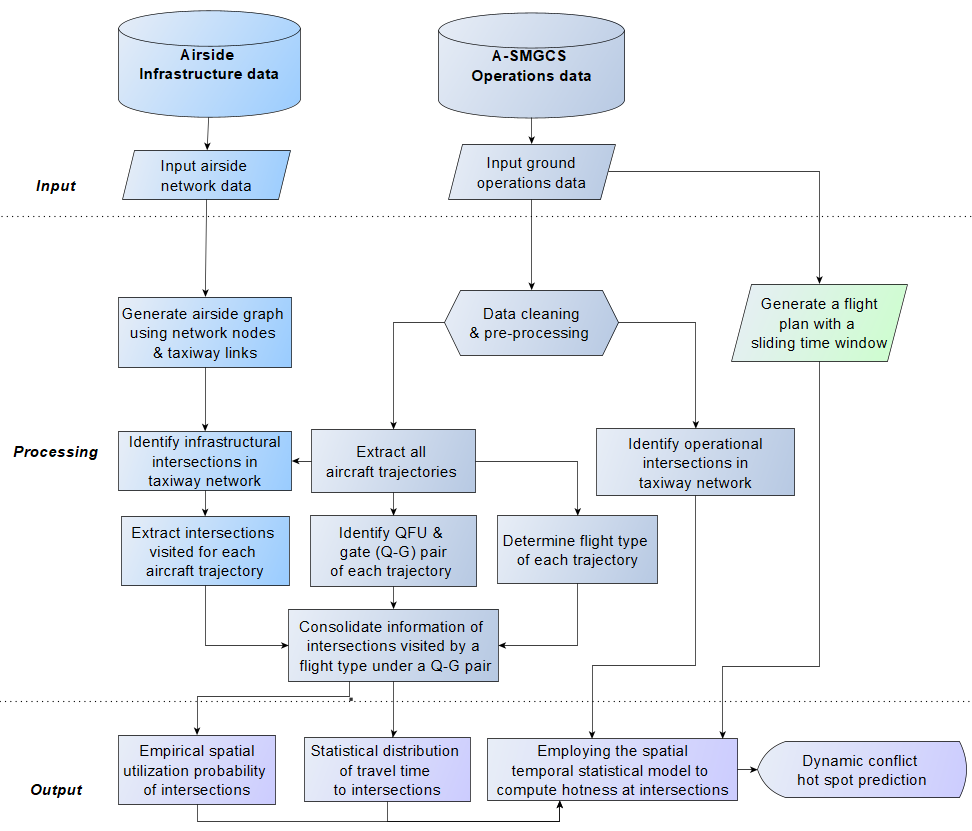publications
An up-to-date list is available on GoogleScholar.
2023
-
 Data driven and learning based approaches for integrated landside airside operations optimizationHasnain AliDoctoral Thesis, 2023
Data driven and learning based approaches for integrated landside airside operations optimizationHasnain AliDoctoral Thesis, 2023Asia has witnessed a meteoric rise in its air traffic in the last decade; leading the region to experience the fastest air traffic growth, globally. However, air traffic infrastructure has not grown proportionately. Many Asian hubs are already operating beyond their designed capacity, resulting in delay proliferation at these airports. Current plans for airport capacity expansions—which are expensive, environmentally sensitive, and often infeasible—will fail to keep up with the predicted traffic demands. This is expected to cause congestion and lower efficiency of airport airside operations (e.g., higher taxi delays). Inefficient airside operations may cause snowball delay effects at terminal gates which, in turn, may impact the airport landside operations (e.g., transfer passenger connectivity). Therefore, airport planners and operators will be tasked with efficiently managing high traffic demands at airports. Airport taxi delays adversely affect airports and airlines around the world, resulting in airside congestion, increased Air Traffic Controllers workload, and adverse environmental impact due to excessive fuel burn. Existing approaches to reduce airside taxi delays include pushback control, efficient path planning, follow-the-greens, autonomous taxiing, etc. Airport Departure Metering (DM) or pushback control has garnered significant research interest in the last two decades. State-of-the-art DM methods use model-based DM policies that rely on airside departure modeling to obtain simplified analytical equations. Consequently, these models fail to capture non-stationarity in the airside operations causing DM policies to perform poorly under uncertainty—inherent to an airport environment. Besides, DM contains congestion by transferring taxiway delays to gates. Therefore, DM has the potential to disrupt scheduled gate assignments leading to passenger missed connections on landside. But current DM research addresses airside inefficiency in silo without considering its impact on landside passenger connectivity. The objective of this thesis is to develop novel methods and approaches, using airside surface movement data, for making airside operations efficient under uncertainty. Furthermore, this thesis proposes an integrated framework to investigate interactions between airside and landside operations for designing gate schedules which are sensitive to transfer journeys of passengers. The scope of the present study is limited to facilitating passenger connections (airline-to-airline transfer) while making airside movements efficient. There are three primary research contributions of this thesis. The first contribution develops a data-driven DM method to minimize airside surface congestion while maintaining runway throughput in an uncertain airport environment. The work casts the DM problem in a Markov Decision Process (MDP) framework and develops a representative airport-airside simulator, using historical surface movement data. The simulator incorporates uncertainties in taxiway movements and aircraft start times to introduce non-stationarity into the simulated environment for making the simulations realistic. The DM policy is, then, exposed to such simulated scenarios and tasked with recommending aircraft pushback times to minimize taxi delays while maintaining runway throughput. For effective state representation, this work introduces taxiway hotspot feature—regions where multiple aircraft may arrive concurrently—which improves the DM policy convergence rate during training. The performance of the learnt policy is evaluated under different traffic densities. Results, on a typical day of simulated operations at Singapore Changi Airport, demonstrate that DRL can learn an effective DM policy to contain congestion on the taxiways; reduce total fuel consumption by approx. 22%; and, altogether, better manage the airside traffic. The second contribution develops a passenger-centric model of airport operations to minimize missed connections in presence of arrival delays at an airport terminal serving low cost carriers. Such operations are highly sensitive to factors such as aircraft delays, turnaround time and flight connection time. The effects of these factors on self-connecting transfer passengers are carefully examined. Results show that the chances of missed connections can be significantly reduced by operationally maintaining higher turnaround time and minimum connection time and by bringing down delays at the airport. Specifically, by maintaining the flight turnaround time at 50 minutes, minimum connection time at 60 minutes and by containing arrival delays within 70% of the current delay spread at Singapore Changi Airport Terminal 4, transfer passenger missed connections can be prevented for almost all the flights. The third contribution proposes an integrated landside airside framework to investigate the interactions between landside and airside operations. The landside simulator simulates transfer passenger movements, and the airside simulator simulates taxiway movements based on historical surface movement data. Departing aircraft movements are then metered to reduce taxi and take-off delays under uncertainties. Delayed arrivals and/or departures may lead to conflicts at gate—rendering planned gate assignments infeasible or impractical. Using Singapore Changi Airport, as a case study, it is found that DM may transfer as much as 12 minutes of waiting time from taxiways to gates. This leads to increased gate conflicts which additionally delays the gate-in time of an arriving aircraft by 2-7 minutes on average. A minimum connection time of 70 minutes is found sufficient, in presence of DM induced delays, to reduce the probability of missed connections for transfer passengers. Congested airports—acting as bottleneck nodes in global aviation network—have far reaching effects on the entire air transportation system. To improve overall efficiency of future airport operations, there is an urgent need for holistically viewing airport as a complex system-of-systems and carefully examining the interdependent nature of airport operations. As copious amount of data becomes easily available, our ability to learn, draw insights and obtain actionable knowledge using past operations data is a pre-requisite for establishing efficient airport operations that are sensitive to passenger needs.
2022
-
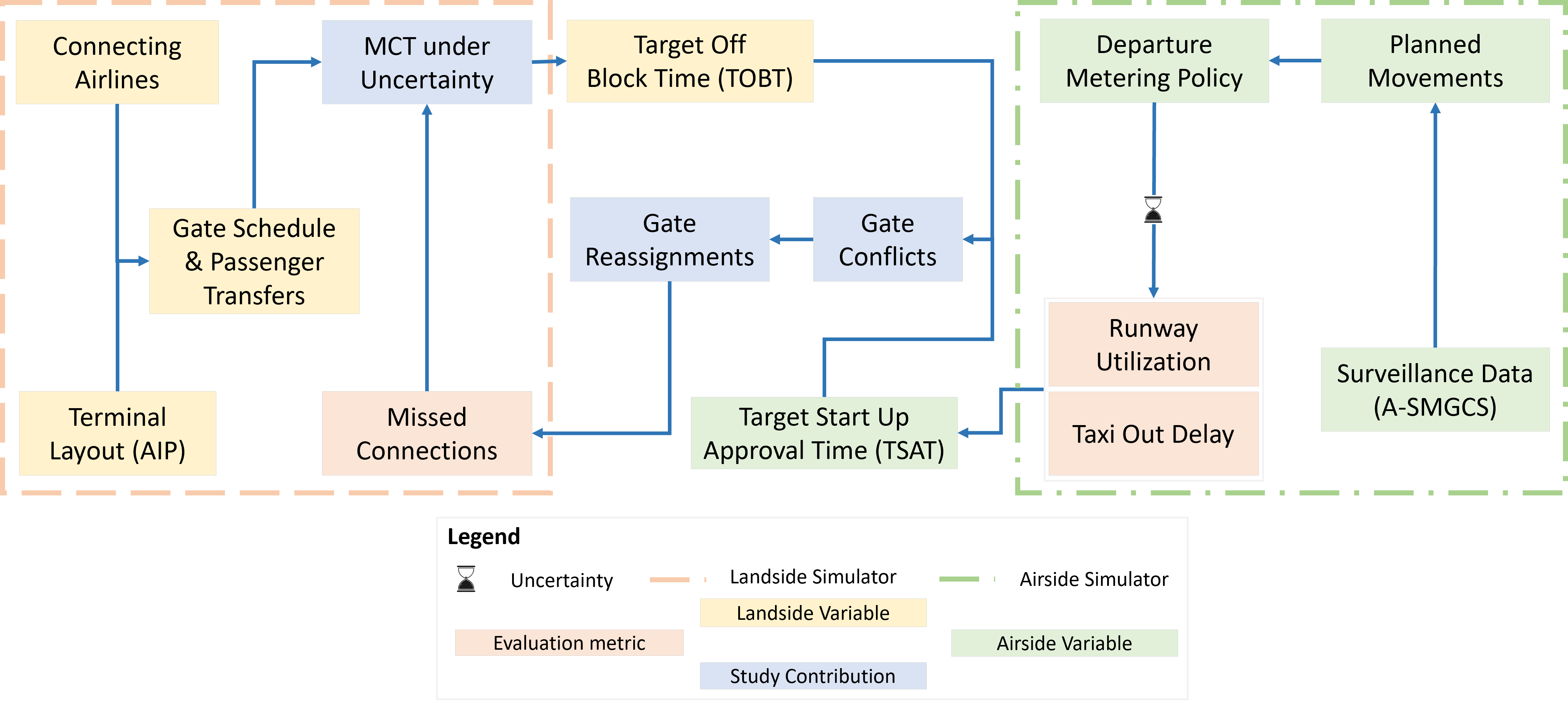 Integrated airside landside framework to assess passenger missed connections with airport departure meteringHasnain Ali, Duc-Thinh Pham, Sameer Alam, and 1 more authorIn International Conference on Research in Air Transportation, 2022
Integrated airside landside framework to assess passenger missed connections with airport departure meteringHasnain Ali, Duc-Thinh Pham, Sameer Alam, and 1 more authorIn International Conference on Research in Air Transportation, 2022Airport departure metering can contain airside congestion but it may adversely impact scheduled gate assignments leading to passenger missed connections. Using an integrated landside airside framework, this study aims at evaluating the impact of departure metering on connecting flights and passenger connections. The proposed framework comprises of landside and airside simulators where the landside simulator simulates transfer passenger movements conditioned upon minimum connection time and the airside simulator simulates runway and taxiway movements based on planned operations and available data source. Departing aircraft movements are then metered to reduce taxi and take-off delays under uncertainties. Delayed arrivals and/or departures may lead to conflicts at gate rendering planned gate assignments infeasible or impractical. Using Singapore Changi airport A-SMGCS data, as a case study, it is found that DM may transfer as much as 12 minutes of waiting time from taxiways to gates. This leads to increased gate conflicts which additionally delays the gate-in time of an arriving aircraft by 2-7 minutes on average. Gate reassignments were found to significantly reduce both the number of gate conflicts and arrival queuing time at gates leading to less passenger delays. A minimum connection time of 70 minutes is found sufficient to reduce the probability of missed connections for transfer passengers.
-
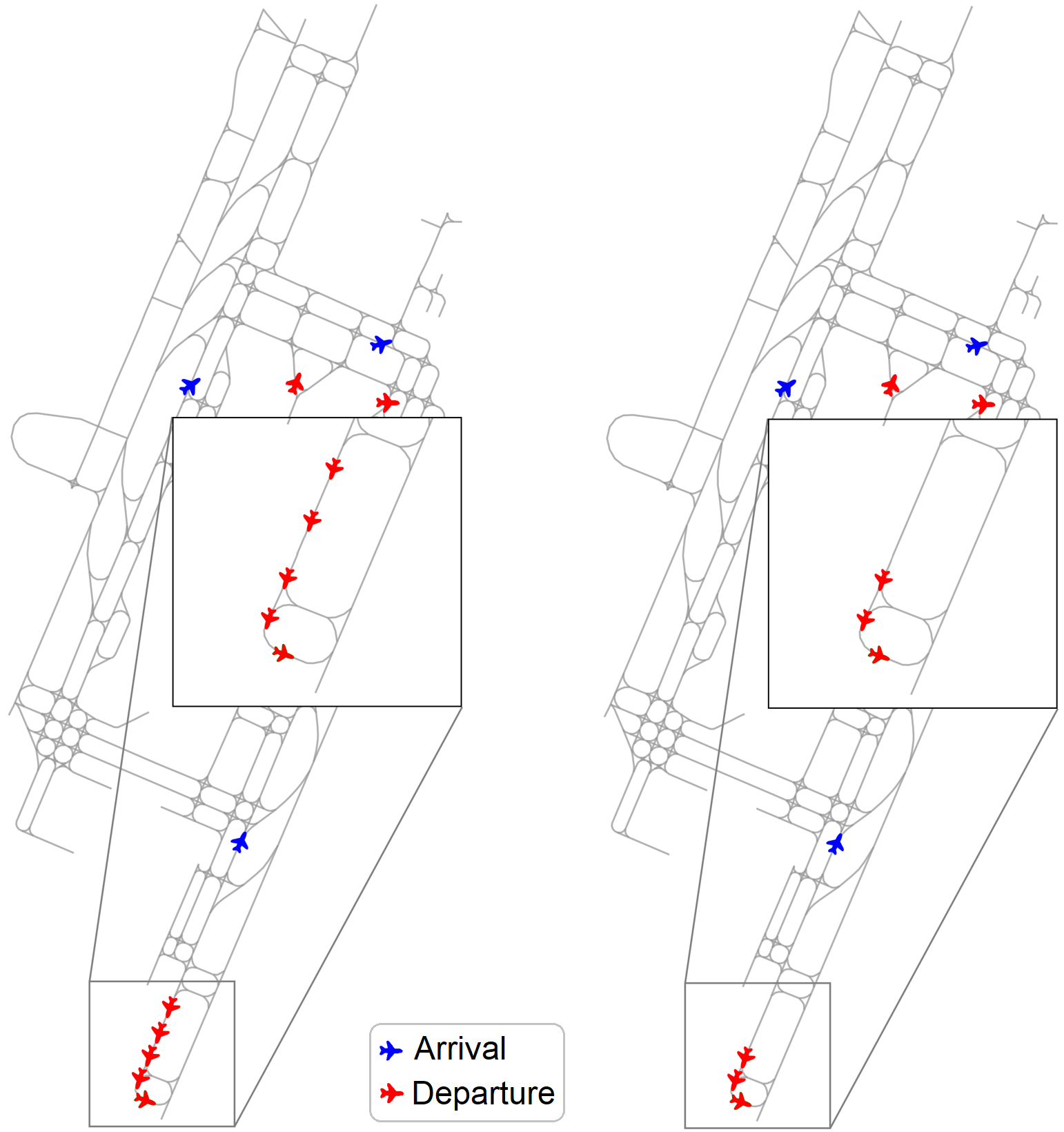 A Deep Reinforcement Learning Approach for Airport Departure Metering Under Spatial–Temporal Airside InteractionsHasnain Ali, Duc-Thinh Pham, Sameer Alam, and 1 more authorIEEE Transactions on Intelligent Transportation Systems, 2022
A Deep Reinforcement Learning Approach for Airport Departure Metering Under Spatial–Temporal Airside InteractionsHasnain Ali, Duc-Thinh Pham, Sameer Alam, and 1 more authorIEEE Transactions on Intelligent Transportation Systems, 2022Airport taxi delays adversely affect airports and airlines around the world leading to airside congestion, increased Air Traffic Controllers/Pilot workload, and adverse environmental impact due to excessive fuel burn. Airport Departure Metering (DM) is an effective approach to contain taxi delays by controlling departure pushback timings. The key idea behind DM is to transfer aircraft waiting time from taxiways to gates. State-of-the-art DM methods use model-based control policies that rely on airside departure modeling to obtain simplified analytical equations. Consequently, these models fail to capture non-stationarity in the airside operations leading to poor performance of control policies under uncertainties. This work proposes model-free and learning-based DM using Deep Reinforcement Learning (DRL) approach to reduce taxi delays while meeting flight schedule constraints. This paper casts the DM problem in a markov decision process framework and develops a representative airport-airside simulator to simulate airside operations and evaluate the learnt DM policy. For effective state representation, this work introduces taxiway hotspot features to account for the spatial-temporal evolution of airside congestion levels. This significantly improves the DM policy convergence rate during training. The performance of the learnt policy is evaluated under different traffic densities with a reduction of approximately 44% in taxi out delays, in medium-density traffic scenarios, which corresponds to 2-minute savings in taxi-out time per aircraft. Furthermore, benchmarking DRL against an evolutionary method and another state-of-the-art simulation-based heuristic demonstrates the superior performance of our method, especially in high traffic density scenarios. With increased traffic density, taxi-time savings achieved by the learnt DM policy increase without a significant decrease in runway throughput. Results, on a typical day of simulated operations at Singapore Changi Airport, demonstrate that DRL can learn an effective DM policy to contain congestion on the taxiways, reduce total fuel consumption by approximately 22% and better manage the airside traffic.
2021
-
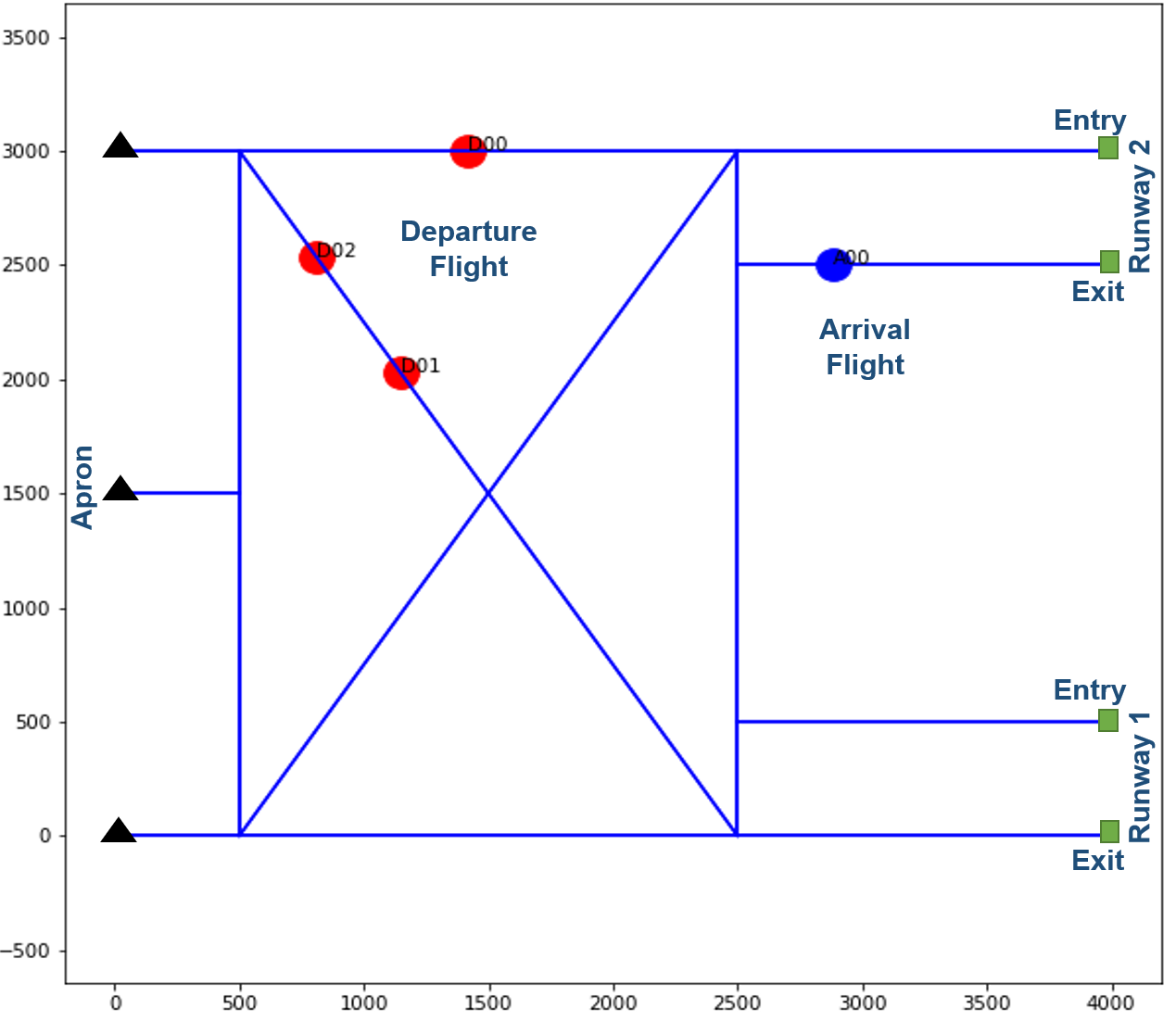 Deep Reinforcement Learning Based Airport Departure MeteringHasnain Ali, Pham Duc Thinh, and Sameer AlamIn 2021 IEEE International Intelligent Transportation Systems Conference (ITSC), 2021
Deep Reinforcement Learning Based Airport Departure MeteringHasnain Ali, Pham Duc Thinh, and Sameer AlamIn 2021 IEEE International Intelligent Transportation Systems Conference (ITSC), 2021In this work, we proposed a DRL approach for controlling pushback times (TSATs) of departures. We employed PPO algorithm to train DRL agent into finding an effective DM policy. Since multiple agents are designed to share a common, single-agent policy, the final learned policy can be copied onto any number of agents. Simulating airside surface traffic in a representative airport environment, it is shown that DRL approach is able to learn, on simulated scenarios, an effective DM policy to contain congestion on an airport airside. As a result, taxi delays and average taxi times are reduced significantly. Through extensive simula- tion experiments, it is demonstrated that the final trained policy naturally scales to various fleet sizes. With increase in traffic density, taxi time savings obtained by the DM policy improves without significant increase in average gate holding times.
2020
- Dynamic Hot Spot Prediction by Learning Spatial-Temporal Utilization of Taxiway IntersectionsHasnain Ali, Raphael Delair, Duc-Thinh Pham, and 2 more authorsIn 2020 International Conference on Artificial Intelligence and Data Analytics for Air Transportation (AIDA-AT), 2020
Airports across the world are expanding by building multiple ground control towers and resorting to complex taxiway and runway system, in response to growing air traffic. Current outcome- based ground safety management at the airside may impede our potential to learn from and adapt to evolving air traffic scenarios, owing to the sparsity of accidents when compared with number of daily airside operations. To augment airside ground safety at Singapore Changi airport, in this study, we predict dynamic hot spots- areas where multiple aircraft may come in close vicinity on taxiways, as pre-cursor events to airside conflicts. We use airside infrastructure and A-SMGCS operations data of Changi airport to model aircraft arrival at different taxiway intersections both in temporal and spatial dimensions. The statistically learnt spatial-temporal model is then used to compute conflict probability at identified intersections, in order to evaluate conflict coefficients or hotness values of hot spots. These hot spots are then visually displayed on the aerodrome diagram for heightened attention of ground ATCOs. In the Subjective opinion of Ground Movement Air Traffic Controller, highlighted Hot Spots make sense and leads to better understanding of taxiway movements and increased situational awareness. Future research shall incorporate detailed human-in-the-loop validation of the dynamic hot spot model by ATCOs in 360 degree tower simulator.
2019
-
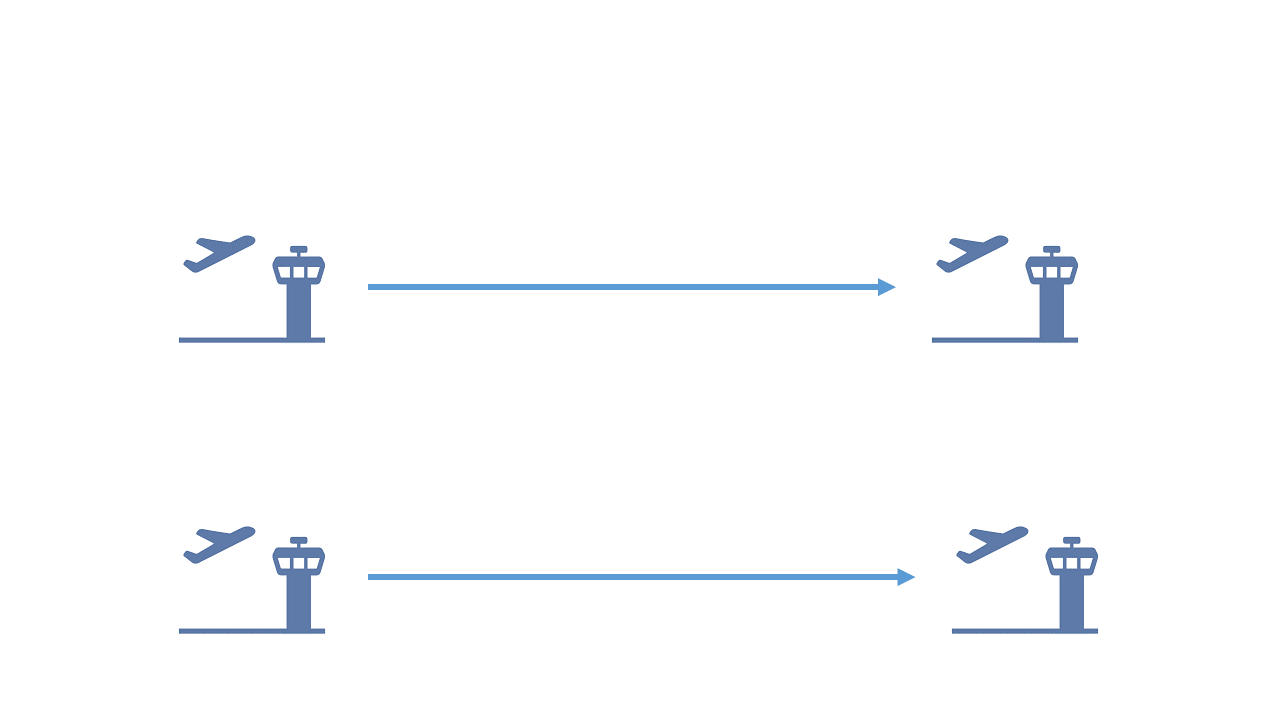 Impact of stochastic delays, turnaround time and connection time on missed connections at low cost airportsHasnain Ali, Yash Guleria, Sameer Alam, and 2 more authorsIn Proc. 13th USA/Eur. Air Traffic Manage. R&D Seminar, 2019
Impact of stochastic delays, turnaround time and connection time on missed connections at low cost airportsHasnain Ali, Yash Guleria, Sameer Alam, and 2 more authorsIn Proc. 13th USA/Eur. Air Traffic Manage. R&D Seminar, 2019Classification is a data mining function which assigns input values to two or more designated classes of output, with the goal of accurately predicting target class for new input data. Discriminant analysis which falls under the broad gambit of classification data mining, is the statistical mapping of data values to one of the two predefined groups. In this study, the application of Ant Colony Optimization to perform discriminant analysis has been explored. Predictive classification accuracy of eighty-six percent has been achieved on an ordinal data set for the combination of one thousand ants and twenty-five instances (minimum) covered by one rule.
-
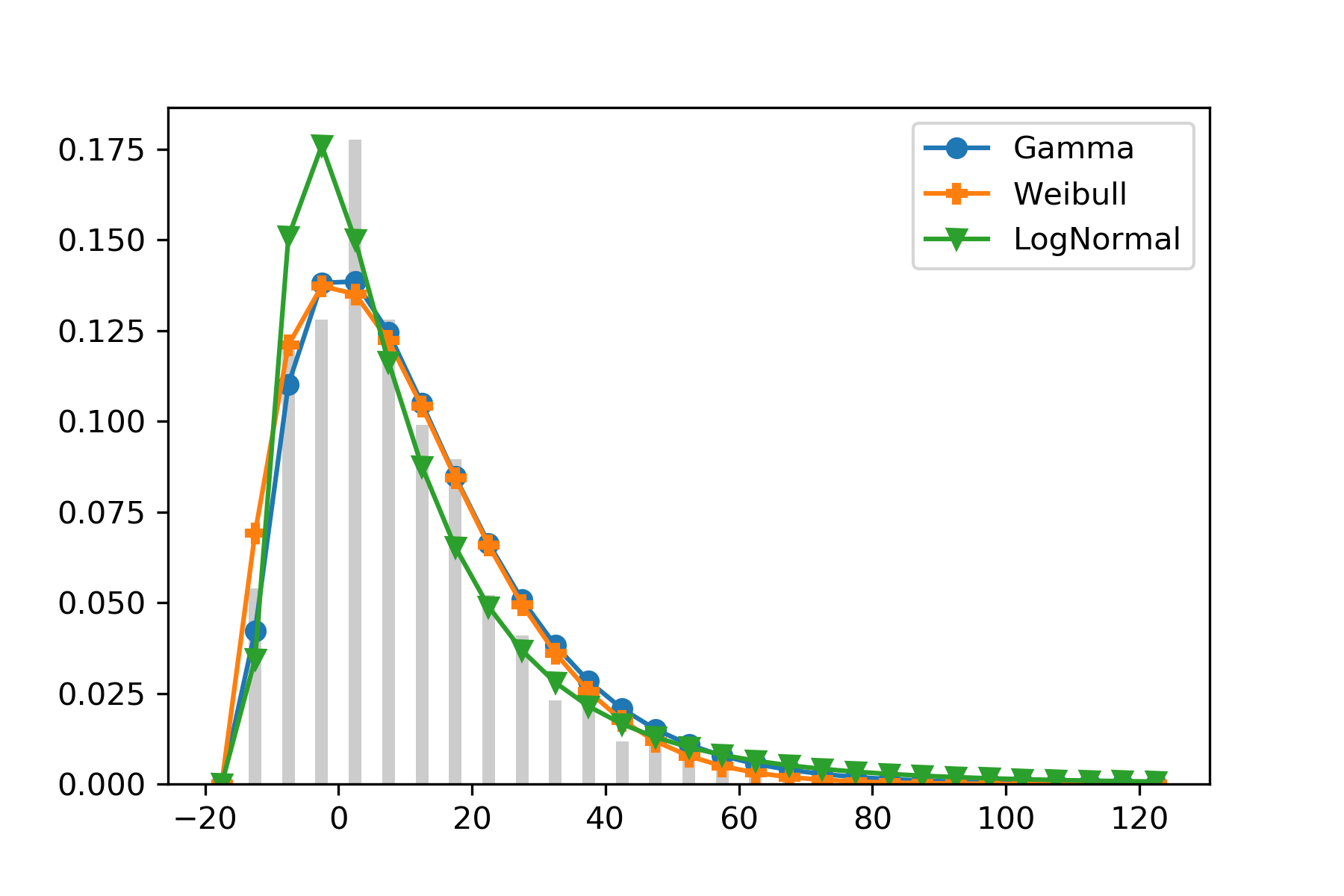 A passenger-centric model for reducing missed connections at low cost airports with gates reassignmentHasnain Ali, Yash Guleria, Sameer Alam, and 1 more authorIEEE Access, 2019
A passenger-centric model for reducing missed connections at low cost airports with gates reassignmentHasnain Ali, Yash Guleria, Sameer Alam, and 1 more authorIEEE Access, 2019Low cost carriers usually operate from no-frills budget terminals which are designed for quick aircraft turnaround, faster passenger connections with minimal inter-gate passenger transfer times. Such operations are highly sensitive to factors such as aircraft delays, turnaround time and flight connection time and may lead to missed connections for self-connecting transfer passengers. In this paper, we propose a passenger-centric model to analyze the effect of turnaround times, minimum connection times and stochastic delays on missed connections of self-connecting passengers. We use Singapore Changi International Airport Terminal 4, which mainly caters to budget/low cost carriers, as a case study to demonstrate the impact of operational uncertainties on these passenger connections, considering an optimal gate assignment by using heuristic search for scheduled arrivals. The proposed model also incorporates reassignment of gates in the disrupted scenario to minimize spatial deviation from the optimized gate assignments. Results show that the chances of missed connections can be significantly reduced by operationally maintaining higher turnaround time and minimum connection time and by bringing down delays at the airport. Specifically, by maintaining the flight turnaround time at 50 min, minimum connection time at 60 min and by containing arrival delays within 70% of the current delay spread at Terminal 4, transfer passenger missed connections can be prevented for almost all the flights. The gate assignment method adopted in this study is generic and may help to identify the gates, which are more prone to missed connections given operational uncertainties under different flight scenarios.
2018
-
 Discriminant analysis using ant colony optimization–an intra-algorithm explorationHasnain Ali, and Arpan Kumar KarProcedia computer science, 2018
Discriminant analysis using ant colony optimization–an intra-algorithm explorationHasnain Ali, and Arpan Kumar KarProcedia computer science, 2018Bio inspired algorithms are machine learning algorithms which are modelled around observed natural phenomenon. Bio inspired algorithms in recent years have been shown to perform data mining tasks with ease by many research studies conducted for very complex domain of NP Hard problems.Ant Colony Optimizationis a bio inspired algorithmwhich addresses such complex problems which requires meta-heuristics based approaches to find solutions. Itis modelled to mimic movement of ants in search for food and is influenced by nature inspired computing paradigms. Computationally,Ant Colony Optimizationexplores and exploits solution space to find fairly accurate solutions in less time.Classification is a data mining function which assigns input values to two or more designated classesof output, with the goal of accurately predicting target class for new input data.Discriminant analysis which falls under the broad gambit of classification data mining, is the statistical mapping of data values to one of the two predefined groups. In this study, the application of Ant Colony Optimizationto perform discriminant analysis has been explored.Predictive classification accuracy ofeighty-six percent has been achieved on an ordinal data set for the combination of one thousand ants and twenty-five instances (minimum) covered by one rule.Comparative analysis of the quality of outcome based on factors like pheromone levels, number of ants and number of minimum instances covered by a rule has been modelled.
